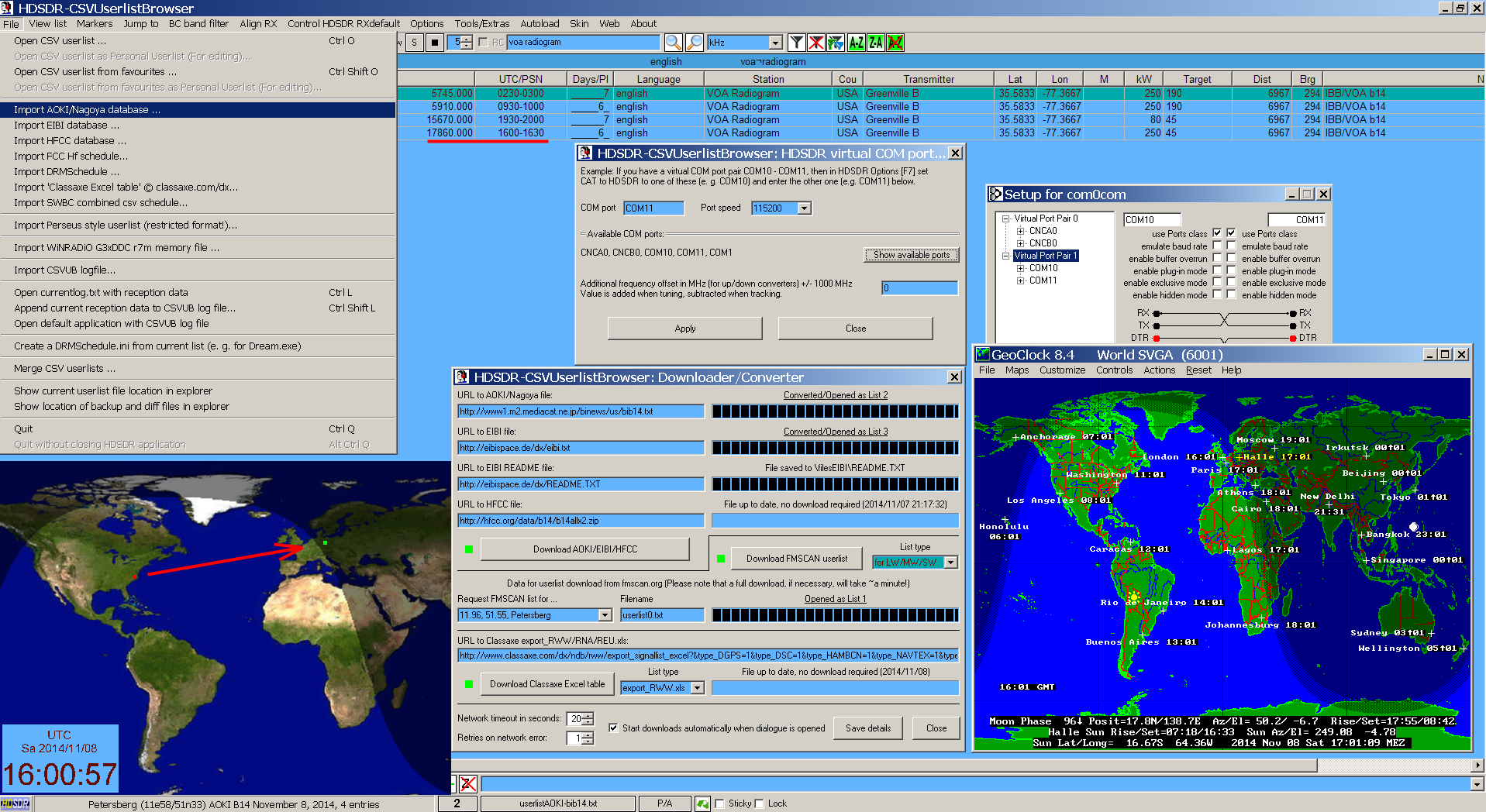
www.rhci-online.net/radiogram/radiogram.htm
██╗ ██╗██████╗ ██████╗ ██████╗ █████╗ ██████╗ ██╗ ██████╗ ██████╗ ██████╗ █████╗ ███╗ ███╗ ██║ ██╔╝██╔══██╗██╔════╝ ██╔══██╗██╔══██╗██╔══██╗██║██╔═══██╗██╔════╝ ██╔══██╗██╔══██╗████╗ ████║ █████╔╝ ██████╔╝██║ ██████╔╝███████║██║ ██║██║██║ ██║██║ ███╗██████╔╝███████║██╔████╔██║ ██╔═██╗ ██╔══██╗██║ ██╔══██╗██╔══██║██║ ██║██║██║ ██║██║ ██║██╔══██╗██╔══██║██║╚██╔╝██║ ██║ ██╗██████╔╝╚██████╗ ██║ ██║██║ ██║██████╔╝██║╚██████╔╝╚██████╔╝██║ ██║██║ ██║██║ ╚═╝ ██║ ╚═╝ ╚═╝╚═════╝ ╚═════╝ ╚═╝ ╚═╝╚═╝ ╚═╝╚═════╝ ╚═╝ ╚═════╝ ╚═════╝ ╚═╝ ╚═╝╚═╝ ╚═╝╚═╝ ╚═╝
|
RSID: <<2014-11-08T12:30Z
MFSK-64 @
6095000+1500>>
<STX>
Eric recently acquired this 2006 Lincoln Navigator with a 5.4
litre V8 engine.
It's bigger than some apartments I've lived in.
In addition to its original petrol tank, it also has a 100-litre
LPG tank. Liquefied petroleum gas is much cheaper in the
Netherlands than petrol -- or what we call "gasoline" in the USA.
<EOT>
<STX>
Sending Pic:125x94C;

<EOT>
██╗ ██╗ ██████╗ █████╗ ██████╗ █████╗ ██████╗ ██╗ ██████╗ ██████╗ ██████╗ █████╗ ███╗ ███╗ ██║ ██║██╔═══██╗██╔══██╗ ██╔══██╗██╔══██╗██╔══██╗██║██╔═══██╗██╔════╝ ██╔══██╗██╔══██╗████╗ ████║ ██║ ██║██║ ██║███████║ ██████╔╝███████║██║ ██║██║██║ ██║██║ ███╗██████╔╝███████║██╔████╔██║ ╚██╗ ██╔╝██║ ██║██╔══██║ ██╔══██╗██╔══██║██║ ██║██║██║ ██║██║ ██║██╔══██╗██╔══██║██║╚██╔╝██║ ╚████╔╝ ╚██████╔╝██║ ██║ ██║ ██║██║ ██║██████╔╝██║╚██████╔╝╚██████╔╝██║ ██║██║ ██║██║ ╚═╝ ██║ ╚═══╝ ╚═════╝ ╚═╝ ╚═╝ ╚═╝ ╚═╝╚═╝ ╚═╝╚═════╝ ╚═╝ ╚═════╝ ╚═════╝ ╚═╝ ╚═╝╚═╝ ╚═╝╚═╝ ╚═╝
RSID: <<2014-11-08T16:01Z
MFSK-32 @ 17860000+1500>>
Welcome to program 84 of VOA Radiogram from the Voice of America.
I'm Kim Andrew Elliott in Washington.
Here is the lineup for today's program (MFSK32 except where
indicated):
1:40 Program preview (now)
2:51 Agriculture with salty water*
8:36 New street lighting lower carbon emissions*
14:43 Glowing orbs mark former Berlin Wall*
21:19 Experiments with 8PSK-125 and 8PSK-250
26:29 Closing announcements
27:07 MFSK64: Veterans Day in the USA
28:46 Surprise mode of the week.
* with image.
Please send reception reports to radiogram@voanews.com.
And visit voaradiogram.net.
Twitter: @VOARadiogram
<EOT>
<STX>
VOA NEWS
Farming With Salty Water Is Possible
George Putic, KI4FNF
November 05, 2014
One of the many adverse effects of global climate change is the
rise of sea levels, which scientists say can increase the
salinity level of fresh water reserves. As saline water cannot be
used for irrigation, farm fields close to the seashore are lost
to agriculture. But a farm in Netherlands has managed to grow
healthy and tasty vegetables in soil irrigated with salt water.
Salinization is reducing the world's irrigated lands by one to
two percent annually, according to the U.N.'s Food and
Agriculture Organization.
But that doesn't faze Dutch farmer Marc Van Rijsselberghe, who
has used saline water to kill some plants in order to identify
which ones are able to thrive.
"We put a lot of plants in the field and then we put them in
fresh water and in sea water and all varieties between it, and
then we see which variety is surviving and which variety is
dying," he said.
Working with scientists from the Free University of Amsterdam,
Van Rijsselberghe and his team divided a farm into eight plots
covered with a network of irrigation pipes.
Separate pipes bring fresh water and sea water to a distribution
center where a computer-controlled system mixes irrigation water
with eight different degrees of salinity.
"And then computer says 'go' and then it goes to the fields and
dripping irrigation starts to work and we are going to kill
plants. That's it," said Van Rijsselberghe.
Numerous sensors continuously control soil salinity and moisture.
Van Rijsselberghe said they were able to harvest vegetables from
most of the test plots. Although they were smaller than normal,
he said they contain more sugar and salt, so they taste better.
"It's a miracle. It shouldn't be a carrot, it should be dying if
we look at the data that are available in the world at the
moment," he said.
The farm managed to grow carrots, cabbage, onions and beetroot,
but potatoes proved to be the most tolerant to saline water. Van
Rijsselberghe said four varieties of salt-tolerant potatoes
recently were shipped to Pakistan where thousands of hectares of
land damaged by salinization are being prepared for testing the
Dutch potatoes.
http://www.voanews.com/content/farming-with-salty-water-is-possible/2510044.html
<EOT>
Image: Screen capture from the video version of this VOA news
story ...
<EOT>
<STX>
Sending Pic:231x160C;
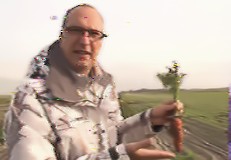
<EOT>
RSID: <<2014-11-08T16:08Z
MFSK-32 @ 17860000+1500>>
<STX>
This is VOA Radiogram from the Voice of America.
Please send reception reports to radiogram@voanews.com.
Better Street Lighting Lowers Carbon Emission
George Putic
November 03, 2014
A United Nations panel on climate change says global warming is
causing extreme weather all over the world and is calling on
governments to come up with new ideas to curb gas emissions.
Since much of the air pollution comes from coal-fired power
plants, scientists in Denmark are trying to lower their nation's
energy needs with new types of smart streetlights.
Our increasingly industrialized world needs huge amounts of
electrical energy, but our power plants still rely mostly on
technology introduced as early as the 19th century - coal-powered
plants, hydroelectric dams or somewhat newer nuclear energy, all
of which have their own shortcomings.
Renewable sources, such as solar plants and wind turbines, have
just started making inroads in lowering harmful emissions, while
safer fusion-based nuclear plants are believed to be many decades
off.
But scientists say we can slow down global warming by lowering
energy demands for street lights.
These common features of the world's urban areas require a lot of
electricity.
The U.S. Energy Information Administration estimates that in
2012, lighting for buildings, streets and highways in the U.S.
used about 274 billion kilowatt hours.
In a bid to make Copenhagen the world's first carbon-neutral city
by 2025, scientists in the Danish capital are testing a variety
of new street lighting technologies.
Kim Brostrom is the chief technical officer at the Danish Outdoor
Lighting Lab.
"We have installed nine kilometers of streets, we have 280 masts
placed here, we have 50 different solutions, we have 10 different
management systems, and we have a lot of different sensors and
things out in the open area," said Brostrom.
Chief science officer Jakob Andersen says the lights can be
managed individually from a tablet computer or a smart phone.
"You can monitor the run time, the efficacy, the lumen output or
the power consumption, and then we do real time measurements on
the lux levels on the street level," said Andersen.
The main goal is to lower energy consumption when the light is
not needed. So the lamp brightens up only when it senses an
approaching pedestrian, cyclist or vehicle. Some of them even
have a backup wind generator or a solar cell.
Scientists say installing the smart lights city-wide could save
up to 85 percent of the current budget for illuminating the
Copenhagen streets.
http://www.voanews.com/content/better-lighting-lowers-carbon-emissions/2506706.html
See also: http://www.lightinglab.dk
<EOT>
<STX>
Image: Examples of innovative outdoor lighting in Albertslund,
Denmark ...
<EOT>
<STX>
Sending Pic:220x144C;
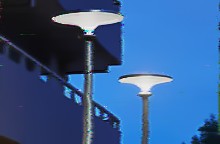
<EOT>
RSID: <<2014-11-08T16:14Z
MFSK-32 @ 17860000+1500>>
<STX>
This is VOA Radiogram from the Voice of America.
Please send reception reports to radiogram@voanews.com.
VOA NEWS
8,000 Glowing Orbs Will Trace Route of Berlin Wall
Matthew Hilburn
November 05, 2014
BERLIN - Walking the streets of Berlin today, it's easy to forget
the Berlin Wall once sliced the city in two, effectively
imprisoning half the city's population.
Countless construction cranes spike the skyline, and in most
places, the wall's scars have healed over. Berlin, which is still
defining itself, is known as "poor, but sexy," a phrase coined by
the city's mayor, Klaus Wowereit.
This weekend, when the city marks the 25th anniversary of the
fall of the wall, two Berlin-based artists, Marc and Christopher
Bauder, will resurrect an ephemeral art installation tracing
where the wall brutally cleaved the German capital.
"Now, it's hard to follow where you are in relation to the former
wall," said Christopher Bauder. "There are some markers on the
ground, but it's easy to lose track. We thought it would be a
good idea to mark the original, to bring it back for a moment for
people who've never experienced the wall."
The "Lichtgrenze," or light border, will consist of 8,000
illuminated, helium-filled orbs tethered to thin poles over a
15-kilometer stretch that passes Berlin landmarks, including the
Brandenburg Gate, the Reichstag parliament building, Potsdamer
Platz and Checkpoint Charlie.
"It's made of air and light," said Bauder, who was 15 when the
wall fell. "It's something very ephemeral as opposed to the
massiveness of the original."
The Lichtgrenze will trace the former wall as accurately as
possible.
"Sometimes, [the installation] runs along the outer wall,
sometimes along the inner wall, and sometimes in the death
strip,'" said Bauder.
The death strip was a wide area between the walls that was filled
with obstructions and manned by armed guards with orders to shoot
anyone trying to escape the former East Germany.
The light border does not trace the former wall perfectly, said
Bauder, because new buildings made it impossible to exactly
recreate the route.
The Lichtgrenze, which is currently being installed, will light
up on Friday and remain lit for three days. On Sunday the
biodegradable balloons will be released and float away. Attached
to the balloons are messages from people who wanted to
contribute.
The notes contain a lot of personal stories and remembrances of
the wall, said Bauder
According to the Berlin Wall Memorial, 138 people were killed at
the wall between 1961 and 1989.
With video:
http://www.voanews.com/content/lichtgrenze-orbs-will-retrace-berlin-wall-25-years/2509554.html
<EOT>
<STX>
Image: Section of the Lichtgrenze ...
<EOT>
<STX>
Sending Pic:437x287;
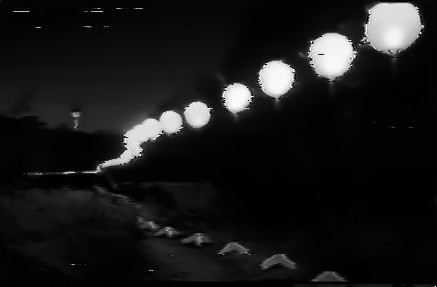
<EOT>
RSID:
<<2014-11-08T16:21Z MFSK-32
@ 17860000+1500>>
<STX>
This is VOA Radiogram from the Voice of America.
Please send reception reports to radiogram@voanews.com.
In the previous VOA Radiogram, we experimented with the 8PSK-125
mode. Most listeners reported at least some errors with this
mode, but there were some 100% correct decodes in Europe and in
North America.
So, with realistic expectations, we will try 8PSK modes again
this week. First will be 8PSK-125 (about 315 words per minute),
followed by 8PSK-250 (about 620 words per minute).
VOA Radiogram now changes to 8PSK-125 ...
<EOT>
|
RSID: <<2014-11-08T16:22Z
8PSK-125 @ 17860000+1500>> |
RSID: <<2014-11-08T16:25Z
8PSK-250 @ 17860000+1500>> |
Here are
combined text
parts of 8PSK 125 + 250 of an IC-R75 + Boomerang and
FRG-100 + dipole. During fading and loss of text on
the 1st antenna then at the 2nd
antenna was better reception. (antenna
diversity with 2 antennas and 2 receivers) |
|
VOA NEWS sophiFttdt tns nox º e rNantd veztpis
Pmym± tAcmost Afghans had to travel to Pakistan to place
VOA Radiogram now changes to 8PSK-250 ...
|
VOA NEWS
|
VOA NEWS
The
video-call technology was first brought to the Afghan Ghani has also used a secure
video conference line to communicate As Qayoumi put it, principal
aspects of Afghan politics will communicating via mobile phones
and online platforms such as
Akmalrnawi is a managing editor
with VOA's Afghan Service. He
|
RSID: <<2014-11-08T16:26Z
MFSK-32 @ 17860000+1500>>
<STX>
Please send reception reports to radiogram@voanews.com.
And visit voaradiogram.net.
Twitter: @VOARadiogram
Thanks to colleagues at the Edward R. Murrow shortwave
transmitting station in North Carolina.
I'm Kim Elliott. Please join us for the next VOA Radiogram.
This is VOA, the Voice of America.
<EOT>
RSID: <<2014-11-08T16:27Z
MFSK-64 @ 17860000+1500>>
<STX>
Sending Pic:230x171;

<EOT>
RSID: <<2014-11-08T16:28Z
Hell 80 @ 17860000+1500>>
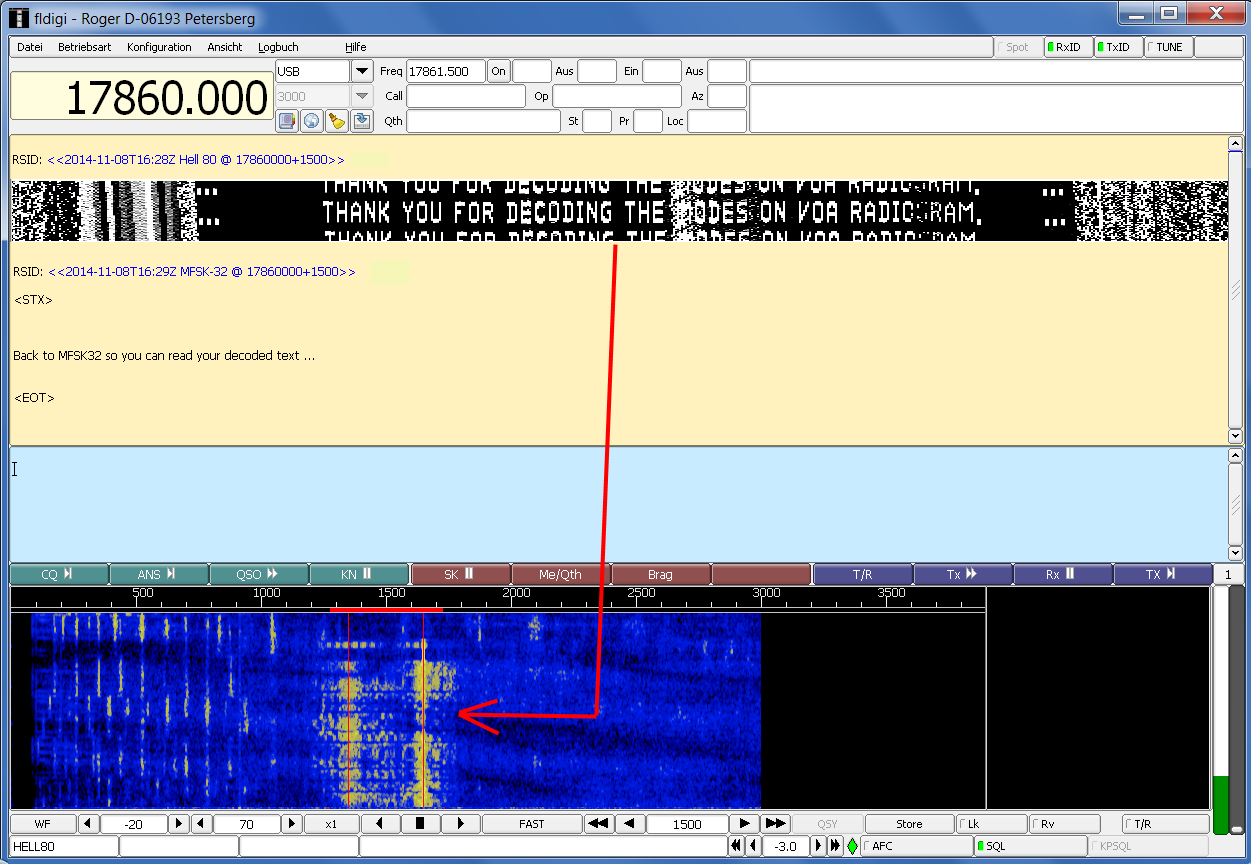
RSID: <<2014-11-08T16:29Z
MFSK-32 @ 17860000+1500>>
<STX>
Back to MFSK32 so you can read your decoded text ...
<EOT>
www.rhci-online.net/radiogram/radiogram.htm
|
QTH: |
D-06193 Petersberg (Germany/Germania) |
|
|
Ant.: |
Dipol for 40m-Band & Boomerang Antenna 11m-Band |
|
|
RX for RF: |
FRG-100B + IF-mixer & ICOM IC-R75 + IF-mixer |
|
|
Software IF: |
con STUDIO1 - Software italiano per SDR [S-AM-USB/LSB] |
|
|
Software AF: |
||
|
OS: |
German XP-SP3 with support for asian languages |
German W7 32bit + 64bit |
|
PC: |
MEDION Titanium 8008 (since 2003) [ P4 - 2,6 GHz] |
MSI-CR70-2MP345W7 (since2014) [i5 -P3560 ( 2 x 2,6GHz) ] |
